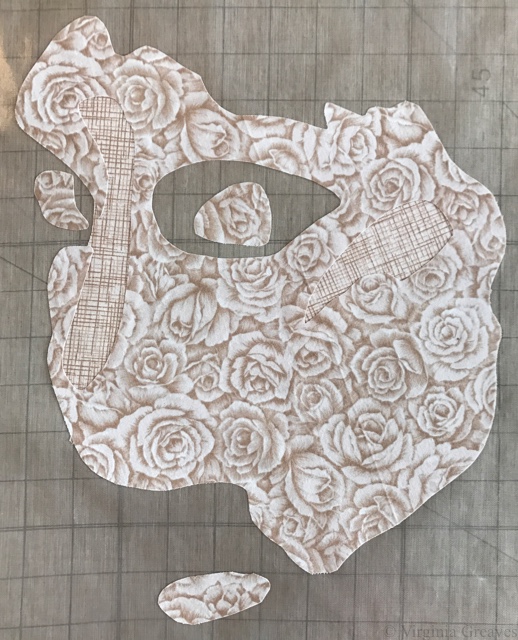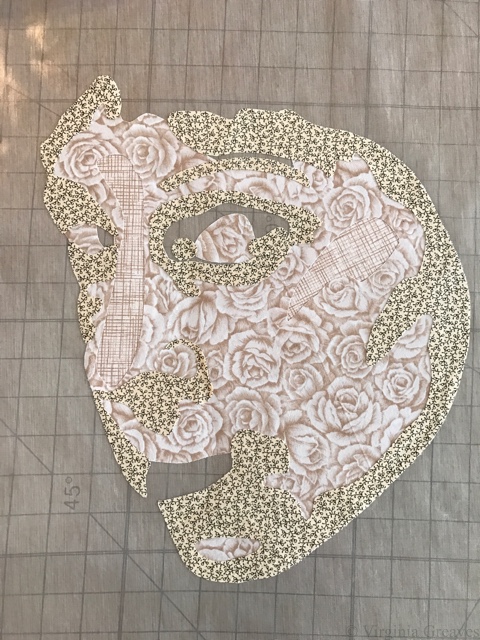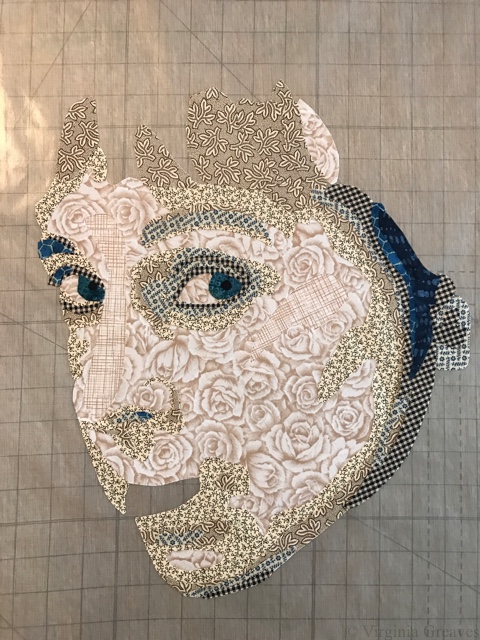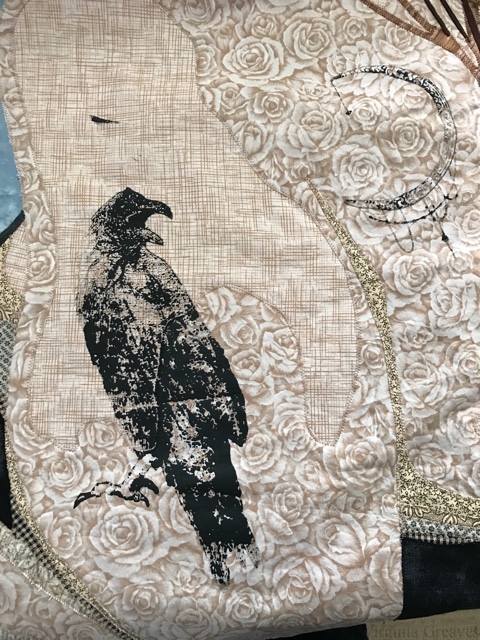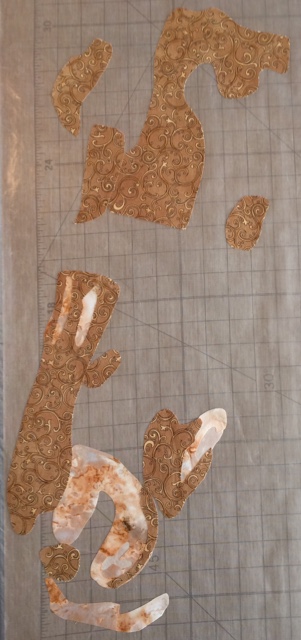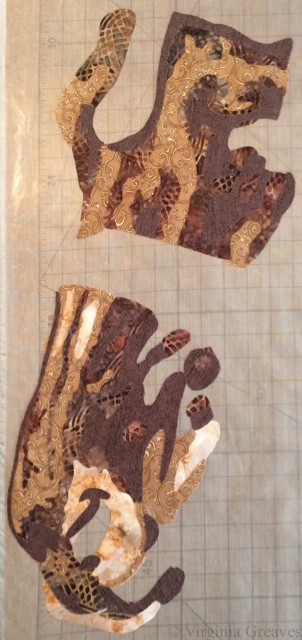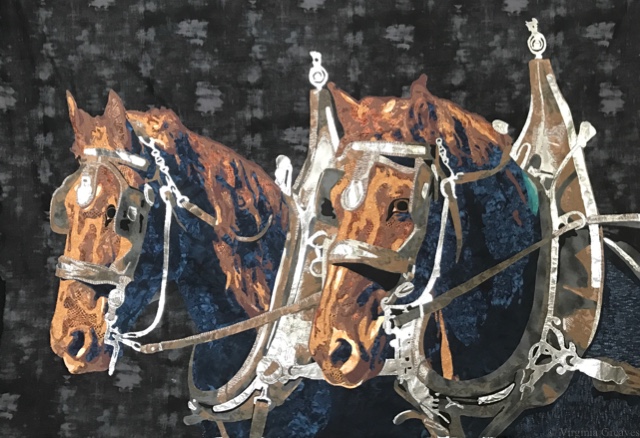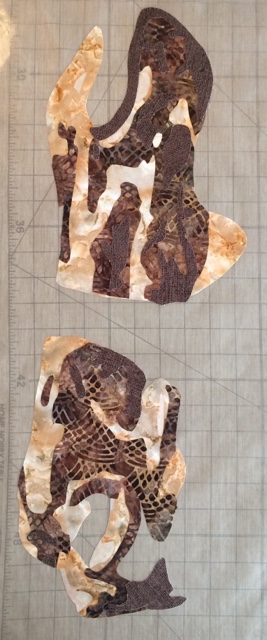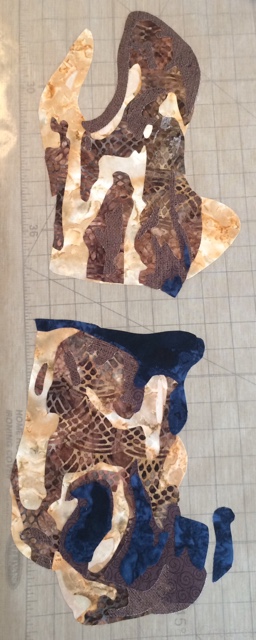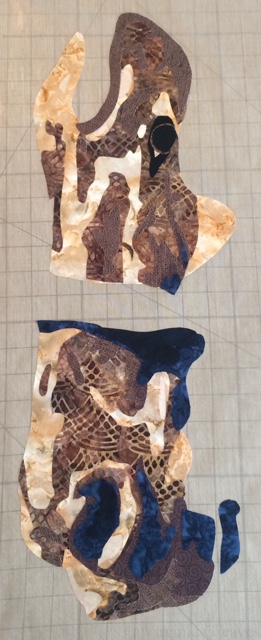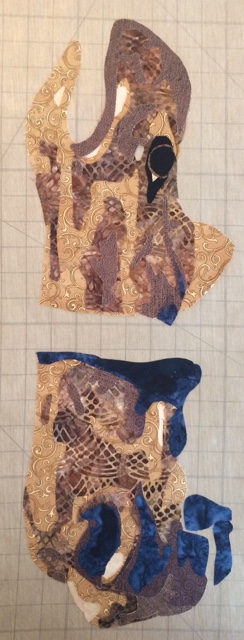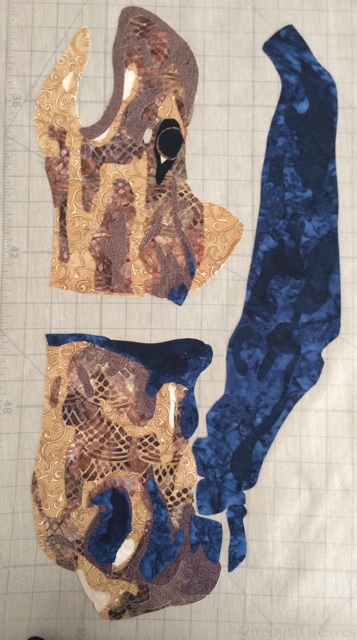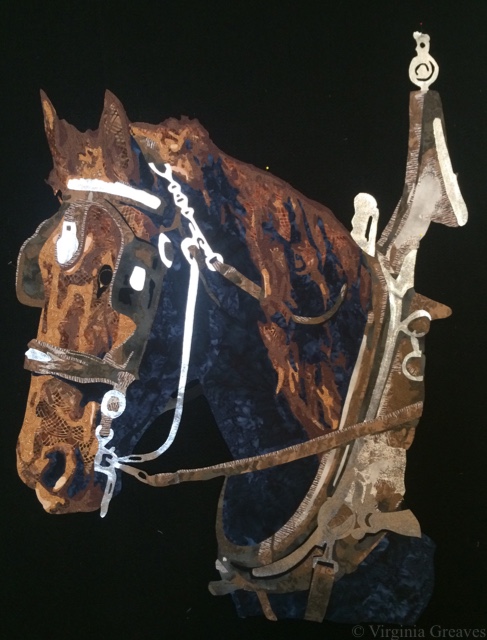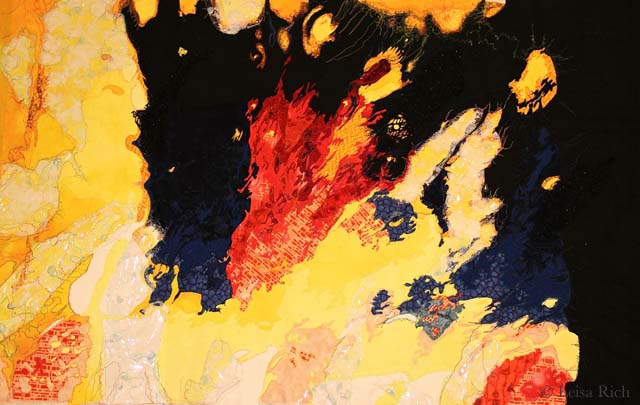Posts tagged artist

Making Tattoo
0Woohoo! My first piece in Dinner@8! I know there are a lot of you that can’t comprehend what a big deal this is, but it’s kind of like winning the lottery. It’s a juried invitational show, so I had to apply to be a part of the Dinner@8 group in order to be invited to make a piece for the current year’s show. After I was accepted, I made a piece according to the theme, which this year was Personal Iconography: Graffiti on Cloth.
I haven’t shown the piece in process on the website because that’s a no-no in this show. Virgin rules, except you can post after acceptances go out.
I’ll admit that I was stumped by this year’s theme. My goal, just as I did the Yvonne Porcella piece (Yvonne in the Garden), was to make a piece that was wholly in my style while still working within the framework of the theme, but I knew that doing that with this theme was going to be hard. I knew that I was going to make a portrait of a person, and I spent some time thinking about how tattoos are so personal and would work well within the theme. My daughter has several tattoos, and she spends a lot of time considering the symbology of each piece and finding the right artist before she gets them. I wanted to honor that, but I also knew that finding a female model would be hard. I envisioned a back shot with the main tattoo on the arm. I’m not entirely sure why, but it seems to me to be a deeply personal pose, enough that I didn’t know anyone personally that I felt I could ask. And really, who’s always available? (Me.) Thank goodness I have a remote control for my camera. I set it up in my studio, and by the end of one afternoon, I had a series of shots I could work with to create what I had in my mind.
I started with the shoulders and back first since the hair would drop over the back. I usually start with the face, but in this instance, the shoulders made more sense. This is the first couple of values.
This is the 3rd value. I ran out of the fabric — or rather ran short on it. I knew I needed enough to cut out for the face and decided that I needed to supplement with a fabric that was close. I could use it on the extended arm and the change would be less visible. (This prompted a late night run to JoAnn’s as it was the only thing open at the time, & I was in the creative head space to keep moving forward.)
This is also the point at which I realized I needed to complete the hand along with the arm — and make sure I had enough fabric to do it as well.
And then I added the deeper values, a dark tan and a couple of dark blues — and then the black garment.
And then I started on the face using the same fabric. These are the first two, and you can just see the basic outline.
This is the 3rd value, the one that I ran out of. I’ve had this fabric for a long time, and I’ll have to try to replace it. (Never let anyone tell you that calicos don’t have value. They’re wonderful for faces.)
This is the 4th value. It inadvertently looks a little like horns, but really, that’s just my high forehead that will go under the hair.
The 5th value. You can tell I was working at night in this one.
And then the rest of the darkest values. I leave the main parts of the eyes and the mouth for the end, so at this point, she looks a little bit like a zombie. I did play around with the darks around the eyes a little bit. I naturally have very dark circles around my eyes, but it wasn’t aesthetically pleasing in the piece, so I backed off on the value a little. (This is part of what I call creative license. Do what’s best for the piece and don’t feel tied to exact duplication of the photograph.)
These are the eyes. Not quite right. I almost always freehand cut these nowadays.
And in this one, a darker blue around the rims of the irises and larger pupils. Then I made the teeth (or the suggestion of teeth) and the mouth.
I did go back later and make the eyebrow on the right darker.
I spent quite some time trying to figure out how I would do the tattoos. I wanted them to look like dotwork tattoos, and so screen printing seemed the way to go. I had, years ago, done some screen printing. What could go wrong? I drew the tattoos in my sketchbook, scanned them, skewed them in Photoshop so they would look as if they were on an arm and tilted across the back, and sent them to Fiber on a Whim to be burned to screens. After fusing my figure to a background and appliquéing it in place, I then screened them right on my piece. What was I thinking? The moon is clean but way too light, and the crow is a mess. I even have a paint blotch above the crow’s head.
With the moon, I just grabbed a fabric marker and filled in all of the light spots to clean it up.
The crow was much harder. I think it sat on my ironing board for at least a week while I thought it over. No use crying over split milk. I had leftover fabric, so I made a bunch of screens of the crow until I got a decent screen. I now have mad appreciation for anyone that screen prints, especially to fabric. It’s much harder than it looks to get a clean screen print.
On the finished piece, I cut out the crow and the blotch. I had to pick out appliqué stitches in two places. Those will be covered by the new crow.
Then I took the new crow, cut around the crow shape, and then fused it onto the arm. I also made a patch to fuse onto the area of the blotch that I had to cut out. Then I ran an appliqué stitch around the crow and the patch. I worried that it would be too obvious around the bottom area where the fabric value is darker, but it’s hardly noticeable on the final piece. There’s only about a quarter inch of light fabric around the crow, and it blends with the fabric it’s next to. In the end, it was a good solution to a difficult problem.
As I was making the piece, I thought it would be cool to add graffiti to the background. That’s why I went with a solid blue background. I even studied graffiti shapes and practiced lettering. I made the graffiti, but then I decided it was too much of an in-your-face interpretation of the theme — so I took them off. That was much worse. So I spent time thinking about the background — and about how I approach my work. In the end, I decided that I didn’t want to be safe, and leaving off the graffiti was safe. Keeping them on there gave the piece a vibrancy it didn’t have without them. So I played with their placement and added black outlines to them and some sparkly points.
You can see the final piece on the Tattoo page here.
Tattoo will premiere in the Dinner@8 exhibit at International Quilt Market & Festival in Houston this coming October/November.

The Creative Spirit
2I’ve been hard at work in my studio since my last post, pouring the creative spirit out of me and into my work. And I’ve surprised myself.
If you remember, I had finished the first horse, so I began cutting out the second horse, its companion. This shows the light values of the face.
And then the darker brown values.
And finally the darkest brown values.
Here is the horse head without all of the leather straps, bridle, and silver.
Then I added all of the leather parts around the face.
And finally the leather collar.
Once I added the silver, I put it up on the design wall for a quick picture.
At this point, I put it up next to the other horse to see how it would look. Wow. I loved it on the black, but I always do.
I considered for a while making a pieced background, but I finally decided that the horses themselves are so intricate, a pieced background would only create a distraction. I found a great smudged black that works well.
This is both of the horses appliquéd onto the background. The grays in the background black look lighter than they actually are — my camera phone is limited in its range and chose to highlight all of the silver. The final photographs after quilting will be difficult, but this piece may warrant my first trip to a professional photographer.
For those interested in the process, I abandoned my usual appliqué technique, which is a tight zigzag around all of the rough edges. Even a free-motion straight stitch around the edges as an appliqué technique was difficult as the pieces tried to pull off as I worked on it. The horses were large and complex, and Wonder Under can only hold so well. The silver, especially, didn’t want to adhere. It was always the first appliquéd for each of the horses.
And the end result is more artistic. I’m letting go of the restrictions of the quilt world and embracing the art side. The free motion stitch is much more like drawing on the piece. I still haven’t decided if I’ll add some tulle for added protection to the raw edges.
They each have their own personalities, and I’m surprised at what has crawled out of my brain.
And now I begin thinking about the quilting process. I have a hard time just pinning this on the wall by myself because it’s so large. I tried to take a local long-arm class at the beginning of the month but it was full. The next one is not until the first of December, and I don’t know that I want to wait, but I’m also uncertain about tackling this bear of a piece on my local machine. I do happen to have a Hinterberg frame that I bought years ago — it sits in pieces in the corner. I abandoned it when I realized that my Viking didn’t have enough harp space for me to use it on the frame. But I did get another 4.5 inches, I believe, in harp space when I upgraded to the Janome. It might be worth trying it.

For the Love
2So after finishing Minerva and going through my Quilt National rejection, I needed a new direction in my work. So I was flipping through photographs that I’ve taken, and I found one of two horses in full military gear that I took during the Gold Rush Parade in Dahlonega last year. I knew instantly that it was going to be my next piece.
It’s the first piece in a while that I haven’t made for a show theme, and I gave zero consideration to marketing it. I am making this simply because I want to, which appears to be feeding my creative muse in a positive way.
And almost unconsciously, I have made this piece huge — which is funny, because two years ago, I would have made something that would fit the size of my table. I suppose I felt the need to make these life size. So the general size of the pattern that I’ve made is 48″ long by 69″ or so wide. And let me just say that making a piece in this scale is daunting. I have broken it up into sections to make it easier — I’m making each horse separately — and for each horse, I make the face, and then the rest of the head, and then the back, and then the neck, and then all the leather, and then all the silver hardware. It still causes unique difficulties. I’m not sure that I can appliqué it in the same way that I usually do — certainly not all at once — maybe not even one horse at a time. And there are so many pieces in even just the first horse, I’m considering doing what I did with the auction piece I did for IQA, Loyal, and using a straight stitch around the shapes instead of my usual zigzag — maybe even incorporating it into the quilting in the same way I did Loyal. I’m even considering covering the piece with tulle like Susan Carlson does, to provide another layer of protection for the raw edges.
But all of that discussion in my head is not while I’m in my studio. In my studio, I am in the zone.
For this piece, the first 2 values are very light — in fact, I probably could have dispensed with the lightest and just used the batik here. It’s hard to discern where the first value even is.
And this shows the 3rd and 4th values. The 3rd value is a batik I’ve always struggled with, but I think it works well here.
For the 5th & 6th values, I purposefully went into navy blues. Painters sometimes use blues for shadows, and I love the richness it gives the piece.
And then I had to construct an eye. In the photograph, there’s a piece of leather to the right of the eye that mostly obscures it. However, it’s important for the piece to have a successful eye. It’s a large part of what draws in the viewer’s eye. So I found a pencil and drew out what I thought would work.
And then I stepped back and really looked at it. I wanted to make sure that the fabrics were working before I continued — and they’re just not. There is a definite value change between two and three, but the step is too great. The horse looks more like a palomino with spots. So I went back to my fabrics and pulled out a honey yellow. Much better, and I can see the first value now.
I recut all the pieces and carefully peeled away the fabric that wasn’t working and re-fused it back together. And then I started on the neck. All the spaces are for leather bridle, harness, et cetera.
And then I went to work and stopped taking pictures. But as you can see, I worked one section at a time so I wouldn’t be overwhelmed. I had fused down all of the horse pieces before doing any of the leather or silver. Here is the horse completed with the leather.
And then here it is with the silver. The only thing I really questioned was the chain running from the top down to the mouth. There really wasn’t an easy way to do it. I may go look for some silver braided trim to use instead.
At this point, she’s finally off the flat table and pinned up on my design. She’ll be the far left horse — that’s why so much of her body is in deep shadow. The forward horse on the right will have a lot more of the brown detail.
I have a few drafting things to finish before I start cutting out the front horse. I also think that I’ll change the horse fabrics a little. I don’t think I’d have enough fabric to make the other one completely anyway. It’s amazing that I was able to get this far without making a trip to the fabric store — well, except for the silver.
And yes, this is silver spandex, just like the gold spandex that I used in The Last Supper. This time I was smarter and fused a non-woven interfacing to it before cutting it out to help control stretch, and then I added the fusible. Last time, I only used the fusible and it was harder to control.

Art, Work, & Life
0I didn’t post on my blog last week. There was a tide of work and life that consumed me and overtook my time. I stole some hours here and there, but I didn’t meet my weekly art goals.
I think everyone struggles with balance. I have work that helps pay the bills, I have a family to take care of, and I have my art that I need — just for me. All three constantly pulling.
I had recently finished cutting out and fusing the 4th abstract piece in the series I’m collaborating on with Leisa Rich. This is what it looked like when I gave it to her.
And she spent a couple of weeks on it. There is a tremendous amount of embroidery stitching on it now — and these very cool things cut from canvas that she printed images on through her printer (have to make a note to try that) as well as vinyl (some in blue!). There is also this cool fabric that’s blue and orange that adds the hot colors more along the bottom.
I love it!
Leisa suggested that I finish this as an irregular shape — not a rectangle. The technical person in me started immediately thinking about how I could do that. We’re also doing some free-form shapes and I pillowcase them — which means I sew the backing onto the front (right sides together) with an opening on the side — and then turn it right side out and topstitch the sides down. That would work here — but I wouldn’t want the edge topstitched on such a large piece. I would just need to hold down that seam while I quilt it — so I’m thinking maybe a water soluble thread. However, if I do this, I can’t quilt it heavily — there would be no place for any stretching to go.
I’ll think on that for a while. For now, I’m still cutting and fusing #5. I should have been done by now, but life keeps getting in the way. Hopefully, I can make a lot more progress this week.
I forgot to take pics of the free floating pieces. These are smaller pieces that Leisa is constructing — and then I’m quilting them and doing the finishing work (or rather in this case, I’m pillowcasing and topstitching the edges of them, which is the finishing, and then quilting them.) Each of these will hang independently on a very large wall and can be moved around depending on the exhibit space. They are less like quilts and are more sculptural in design.
We’re making great progress. I have at least 3 more pieces to plan, but we have until October when the show opens here in Atlanta.

Working From Photographs
0This morning, I was spending a few minutes on Facebook, and Dorte Jensen, who was accepted in SAQA as a JAM member at the same time I was, posted a picture of a piece she made of Lincoln to the Art Quilts page. Given the recent discussion of the use of historical photographs in your artwork, I couldn’t help but think that comparing her picture of Lincoln to mine makes my argument all too clear — that the use of a photograph as inspiration does not mean that the artist is merely copying the photograph. Obviously, there is immense skill in drafting a pattern from any photograph and rendering it in your own style.
Although the inspirational photograph for her piece is slightly different than the one I used, it is obvious that our styles are completely different.
This is Dorte’s piece.
And this is mine.
If our pieces were merely copies, they would look almost identical. Clearly they do not. They each have their own spirit and life and attributes that make each one special.
Dorte has also recently made a piece of Ben Franklin that is marvelous. I hope you enjoy her website.
As portraitists, it is inevitable that we will turn to historical photographs if we want our work to be marketable. The skill with which they are rendered are no less than if we were to use one of our own photographs. As long as the copyright is clear, they are a wonderful source of inspiration.

2014 Accomplishments
1At the end of the year, I look at my goals and see how close I came to achieving them. Here is it January 8th — I should have done this at the end of 2013 — but I got the flu after Christmas, and it took all of my energy for a couple of weeks. I’m just now beginning to recover and put together the pieces of everything I have to do in my life. Today was the first time I’ve had to look at my art goals.
2013 was the year that “I finally broke into the sunshine at the International Quilt Festival/Houston” — and 2014 was the year that I created controversy. But just like I said last year — I’m still here and kicking — and I hope to continue to create in 2015.
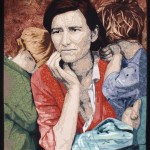 — My blog was viewed 21,00 times in 2014 which broke all of my previous records. The highest viewed post was The Use of Someone Else’s Photograph in Your Work, the subject of which was the controversy over my piece Worry at the International Quilt Festival/Houston this year.
— My blog was viewed 21,00 times in 2014 which broke all of my previous records. The highest viewed post was The Use of Someone Else’s Photograph in Your Work, the subject of which was the controversy over my piece Worry at the International Quilt Festival/Houston this year.
— Worry and Golden Moment were accepted into Georgia Artists at the Abernathy Arts Center here in Sandy Springs, GA, an exhibit highlighting the work of local Georgia artists from all mediums. Golden Moment won 1st place.
— Worry was accepted into International Quilt Festival/Houston: World of Beauty and was awarded 3rd place in the Art-People, Portraits, and Figures category.
— Dolce Far Niente was accepted into the special exhibit What’s for Dinner? at Quilt Festival/Houston.
— The Cardinal was shown at the Square Foot Fiber Art Pin Up Show at the Southeast Fiber Arts Alliance here in Atlanta and then was donated and auctioned at the International Quilt Festival/Houston Silent Auction.
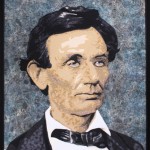 — Lincoln traveled from the 2013 International Quilt Festival/Houston and went to The Texas Quilt Museum, Spring Quilt Market in Pittsburgh, International Quilt Festival/Chicago, and Quilt! Knit! Stitch! in Portland before being purchased.
— Lincoln traveled from the 2013 International Quilt Festival/Houston and went to The Texas Quilt Museum, Spring Quilt Market in Pittsburgh, International Quilt Festival/Chicago, and Quilt! Knit! Stitch! in Portland before being purchased.
— Beach Guardians traveled from the 2013 Sacred Threads show and went to Sacred Threads West: Art of the Sacred in Seattle, WA.
— Rebecca Reasons-Edwards and myself co-curated another exhibit this year called Fierce Fibers at The Art Place in Marietta, GA. Beach Guardians, Golden Moment, A Walk in Twilight, and Worn were exhibited.
— Golden Moment was accepted into Art Quilts XIX: Permission to Play at the Chandler Center for the Arts in Chandler, AZ and was awarded Juror’s Choice & 3rd Place.
— Firecracker was included in the article Pet Portraits Popular With Owners Who Quilt in the Daily Sentinel published in January.
— Heike Hellmann-Brown wrote an article about me and my work that was published in the local publication North Fulton Family Life in August.
— Sold Lincoln to a private collector.
— Sold I Am the Vine, You are the Branches to a private collector.
— Sold Worry to a private collector.
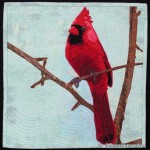 — Sold The Cardinal to a private collector.
— Sold The Cardinal to a private collector.
— Met goal of selling at least 2 of my pieces.
— I completed 3 large portraits, 1 small animal portrait, 1 small abstract, and 3 large abstracts. (All of the abstract works were made in collaboration with Leisa Rich.) (Goal to make at least 6 large pieces met.)
— I started a collaboration with a local artist, Leisa Rich. We have been working on an abstract series based on car washes and are planning a two person show at the Abernathy Arts Center in October of 2015.
— I applied and was accepted into Studio Art Quilts Associates as a Juried Artist Member.
— I spoke at The Atlanta Modern Quilt Guild in Marietta, GA, The Alpha Arts Guild in Alpharetta, GA, and the Misty Mountain Quilter’s Guild in Blairsville, GA.
— This year I kept a massive spreadsheet and kept track of my hours. I have to find a simpler way to do this. Halfway through the year, I decided that I not only wanted to keep category totals but also totals by project — so I ended up keeping two separate spreadsheets.
— As of the end of the year, I have 115 FaceBook Page followers (increase from 2013 unknown but I think it’s around 50%) and 32 Twitter followers (52% increase but still small).
— I did fairly well on maintaining my social media goals. I posted at least 2 blog posts a week 80% of the time, I posted at least 4 FaceBook page updates 78% of the time, and I posted at least 6 Twitter updates 74% of the time.
— What I didn’t do well with this year was keeping myself to at least 15 hours per week in the studio. I only met that goal 59% of the time. I was on track until I started taking freelance scoping work on the side. The truth of the matter is that my family is a part time job, so freelancing work cut into my art time. I do think I will keep this goal in 2015 however. I just need to work on being smarter with the time that I do have available.
— I didn’t keep my sketching goal at all. I have no problem drafting out a pattern for a particular project, but I can’t seem to make myself stop and fill a page in a sketchbook.
— I easily increased web traffic 5%. Given the controversy over Worry at IQA/Houston, my traffic increased 55.4% over last year.
I am eternally grateful for the support and encouragement of my friends and other people that reached out to me during the controversy over Worn. I am reminded that my place is to hold up others to the light and forward their achievements in a positive way. I leave all the others that still have lessons to learn — behind.
Love me or hate me, I’m still here, and I hope that 2015 is a great year.

Around the World
0Last year in Houston at Quilt Festival, I had the pleasure of meeting Marilyn Wall. I had admired her work for some time and was excited to meet her. She was attending with an old friend of mine, Denny Webster, who had recently moved from Atlanta to North Carolina.
Marilyn asked me recently if I was interested in participating in the Around the World blog hop. I’ve never done one of these before, but it’s essentially a way for bloggers to promote each other. Marilyn nominated me and another blogger — and I’m supposed to nominate a couple of other bloggers. Hmmmm. Most of the bloggers I know have already participated in this blog hop — and quite frankly, life has been very full around here recently.
BUT — what I CAN do is introduce a few things about me that you might not know.
What quilting/sewing thing am I working on?
If you follow my blog at all, you see what I’m working on. Right now, in my studio, I’ve been cutting out a portrait — I’m working on the hair right now. I’ll blog post about the face later this week. It’s my intention to enter this one in the National Portrait Gallery competition and hope it at least makes it to the semi-finals. Hope springs eternal. And in a little over a week, I’m traveling to Quilt Festival in Houston to step out in the Winner’s Circle and find out what my prize will be. I’m starting to feel butterflies in my stomach.
How does my work differ from others of its genre?
This is an interesting question. I started making representative patterns because I enjoyed the process, and my first series of portraits were all monochromatic color studies. Once I moved to Georgia and no longer had a wet studio, I was forced to begin considering commercial prints in portraits, and in this, I was definitely influenced by Deidre Scherer. I studied how she used patterns to her advantage rather than seeing them as an obstacle. I also studied Charlotte Warr Andersen, although all of her faces were made with solids. In the end, I made what I wanted to make. The norm at the time in fabric portraiture was not detail but rather obscurity — the side of the face or the back of the head, a closed mouth, a limited value range. I challenged myself to do teeth, to suggest the gum line or the tongue, to add the intention of the ear. I also made surprising fabric choices, not shying away from patterns, and learned how to make them work for me.
Why do I write/create what I do?
I create what I do because it makes me happy. It’s challenging, and I enjoy a challenging puzzle. I remember taking a picture of my daughter and making it into a pattern — and I loved to see the light of her eyes shine out at me from the design wall. I loved taking the impossibility of a waving flag and successfully presenting it within the confines of my 2D fabrics and the sculpture of my quilting thread.
How does my writing/creating process work?
Now this is a really long thing for me to answer succinctly. I have a picture for inspiration (usually one that I’ve taken but sometimes one that I’ve asked permission to use) and from that, I make a value painting in Photoshop (which means that I draw all over it because pictures are only the beginning and will never give you everything that you need because they are not as good as the human eye). From that, I make a pattern. From that pattern, I create fabric templates that I collage together (cutting and fusing — this is secretly my most favorite part). I then stitch it all together through raw edge appliqué, and then I quilt it.
That’s my story. I’ve had my website since April 2005 because I have always enjoyed computers and it was a way for me to stay connected when I lived in a small town in Alabama (particularly when I became a stay-at-home mom), and I started the blog in September 2007. I had been a writer in my youth, and I have enjoyed adding writing as an expression of my creative intentions. I have enjoyed my journey — and I’ve enjoyed sharing it with anyone that has cared to read it and follow it here.

Leisa’s Turn with Abstract #3
0Leisa and I are having a such an exciting time with this series. It is so much fun to see what the other is going to do with the work. This is the 3rd one that we’ve done and we’re already planning #4 and #5.
I was wrong — this is not the one Leisa plans to cut into strips. In fact, she cut off all the extra yellow and black that I had added at the top and bottom and returned it to its horizontal orientation. I just chuckled. I liked it better that way too but it was her prerogative.
She free motion embroidered it like crazy, added black lace, painted it, added vinyl, and painted some of the vinyl (on the inward facing side) with nail polish. It gives it the coolest effect. (I’ll have to be careful about quilting those sections lightly though. I’m a little worried if you can needle through nail polish.)
And this is a detail shot — you can see the wandering embroidery lines a little bit better here.
It’s interesting to see the unintended forms that come out of this process. I love where this one is going. I’m going to quilt it and then let Leisa have another crack at it — she is thinking about adding handwork after the quilting.
I have finished the binding on #2 — and I’m almost done with adding the sleeve. I do think I’ll have to add another one though. It’s not straight across at the top so figuring out how to sleeve this one has been a challenge. I added a short sleeve at the very top where it is straight — I think I’ll have to add another one lower down on the other side. I couldn’t work it into the binding edge thought because it isn’t straight.
And then I need to bind and sleeve #1, the first small one that we did. I’m having to use different techniques on these. For instance, I couldn’t pin baste #1 because of the vinyl — I had to spray baste. I’ll have to do the same with #3. #1 also has a lot of vinyl on it around the edges — so it occurs to me that can’t use my usual water soluble glue trick to help me bind the edges (which thankfully are at least straight on this one).
And because of this issue, I realized that I probably shouldn’t use my usual blocking technique on these — particularly the ones with vinyl. If I soak them in water, the vinyl may inhibit evaporation and could lead to molding — a distinct possibility as I live in the Deep South — so I’m going to forego that as well. I haven’t had a waviness problem on any of them — yet — but if it becomes an issue, I’ll block them with spritzes of water — not a full soaking.
I need to make myself stop. It’s September and I would like to have a piece to enter in the Outwin Boochever Portrait Competition sponsored by the National Portrait Gallery. I need to start photographing inspiration for that one. I entered a few years ago and wasn’t juried in so I just assumed that it was a bias against alternative mediums. Completely untrue. Be careful not to create obstacles for yourself that don’t exist. Last year, the People’s Choice award winner was a sculpture made from rice, rice noodles, and glue by Saeri Kiritani — and there was a fiber finalist — Lia Cook. I can’t be accepted if I don’t enter. You can see last year’s winners here.

Tweek!
0 My youngest daughter went on a school trip to DC this last week with her dad as a chaperone — so it was just me and DD1. At her age, she doesn’t always acknowledge my existence so I spent a lot of extra time in the studio — almost twice as much as in a normal week. On my current piece, I’ve cut out everything but the roof — and after that, I’ll start sewing everything down in sections. I’ll write about it here on the blog so look for an update soon.
My youngest daughter went on a school trip to DC this last week with her dad as a chaperone — so it was just me and DD1. At her age, she doesn’t always acknowledge my existence so I spent a lot of extra time in the studio — almost twice as much as in a normal week. On my current piece, I’ve cut out everything but the roof — and after that, I’ll start sewing everything down in sections. I’ll write about it here on the blog so look for an update soon.
This is my weekly Twitter update about articles I found interesting during this past week. If you want to follow me in real time, you can find me @vsgreaves or hit the Twitter icon in the upper right hand corner above the menu. The FaceBook icon next to it takes you to my professional Page — I update pics on there a few times a week.
As part of the ongoing discussion about how a small elite set of investors churn the work of a small elite group of artists to increase the size of their investment portfolios, this article focuses on the fortunes of Oscar Murillo, a young 28 year old in the elite artist group. The concern is whether his early fame will lead to an early burn-out of interest in his work. Will his work endure or is it merely “trendy and derivative”?
Too much too fast — just let the artist be the artist. But is fame bad? http://tinyurl.com/km5a88j @nytimesarts
Self identifying as an artist makes a difference. Interestingly, I sometimes do — sometimes don’t. It depends on the form and my current mood. The study covered in this article finds that a lot of artists don’t self identify as an artist.
“What Makes an Artist an Artist?” Sometimes I self-identify as an artist — sometimes I don’t. http://feedly.com/e/pZHrYdUZ
Since the majority of artists don’t make anywhere near where the upper elite artist group does, it makes sense that they typically come from wealthy parents — not because they’re being funded by them but that they have different opinions about fulfillment and how it relates to money. (I did still find it depressing that Creatives typically make so little compared to everyone else. It’s a sad statement on our culture that it’s so undervalued.)
“How Wealthy Are Artists’ Parents?” Identifying as a prof artist enters you in an elite status group. Who knew? http://feedly.com/e/bxCdlmUp
All Creatives need help working through artistic blocks from time to time.
“Artists Offer Their Escapes from Creative Block” Hoffman: “work every day like the manual laborer that I am” http://feedly.com/e/khBsDbjz
So many businesses look at traditional metrics in hiring decisions. It’s nice to see at least one company that is assessing the success of candidates based on soft skills — learning ability, emergent leadership, humility, and ownership — and at the bottom of the list, expertise.
“How to Get a Job at Google” The importance of soft skills – Why can’t Google be headquartered in ATL? http://feedly.com/k/1p9fChk
If we can figure out what the market wants to buy, should we change what we create — or at least reach a compromise?
“Thinking About Art Practice and the Role of Compromise” I’m not the only one asking what Is sellable. http://feedly.com/e/XgswtSHP
The LA Times looks at the recently published TEFAF Art Market Report issued by the European Fine Arts Foundation. The news is sobering.
RT @abstanfield Report: Super-rich, favoring just a few artists, drive art market http://www.latimes.com/entertainment/arts/culture/la-et-cm-art-market-prices-auctions-billionalires-20140316,0,6445724.story … <worth a read

Tweek!
0 Another week has gone by — January is disappearing fast. I am hoping to finish my current piece by the end of the month — but I have a lot of personal roadblocks in the coming week — so that may just not be possible. I have finished all of the appliqué and I’m getting ready to start quilting it. Wish me luck.
Another week has gone by — January is disappearing fast. I am hoping to finish my current piece by the end of the month — but I have a lot of personal roadblocks in the coming week — so that may just not be possible. I have finished all of the appliqué and I’m getting ready to start quilting it. Wish me luck.
I shared a lot of fun articles this week — and this is my weekly summary. Remember if you want to follow my posts directly on Twitter — I am @vsgreaves — or click the Twitter icon in the upper right above the menu. You’ll also notice the Facebook icon there next to it — that will take you to my Facebook Page.
This is Kathleen Loomis’s review of the book Thinking Through Craft by Glenn Adamson — sobering view of the art world — but I’ve definitely put this book on my reading list:
“Clawing your way out — or in” of the “art world” http://artwithaneedle.blogspot.com/2014/01/clawing-your-way-out-or-in.html
I’ve become a big believer in tracking your progress — even if you’re a studio artist and you’re only accountable to yourself:
““The Ostrich Problem” and The Danger of Not Tracking Your Progress” http://feedproxy.google.com/~r/The99Percent/~3/hy5rJbiMTIE/the-ostrich-problem-and-the-danger-of-not-tracking-your-progress
I’m always interested in marketing my work and finding new information that will help:
How Artists Can Make Art That Will Sell – Artpromotivate http://buff.ly/1i8N5DV via @ArtProMotivate
Lisa Call is textile artist that I started following a couple of years ago because she’s so successful at making a lot of work and selling it — so when she talks, I listen:
“To make it happen, I write it down” @lisacall http://tinyurl.com/nssckaj
Since I photograph my own work, I’m always interested in fine tuning my textile photography skills:
How to photograph textile art http://tinyurl.com/kdrjw6n
I liked this article — it talked about getting your brain into the flow and why critiquing can be harmful to that:
“Work First, Critique Second” getting into the creative flow http://feedproxy.google.com/~r/The99Percent/~3/FK_gfyT5D7I/work-first-critique-second
I share all of my in process work on my blog — which is ironic because I’m highly protective of sharing the work out of my studio. When someone comes to the house, I typically cover it up so it won’t be seen — because, as the previous article mentioned, criticism can be harmful to flow. There are only a couple of people that I’ll discuss in process work with — but I suppose my blog hasn’t contradicted that rule because I don’t typically receive a lot of comments. This article argues that sharing work with the masses can be harmful to the creative cycle and that special support groups are what is needed.
“In Praise of the Creative Support Group” http://feedproxy.google.com/~r/The99Percent/~3/CjJUNjy1SHk/in-praise-of-the-creative-support-group
This article is written from the perspective of a photographer but still has an important lesson — if you’re given lemons, make lemonade:
“Use Optimism to Avoid “Work Paralysis”” http://feedproxy.google.com/~r/The99Percent/~3/L1X6FzTnjao/use-optimism-to-avoid-work-paralysis
I found this discussion of ivory an interesting one. Ivory is typically used as a carving medium for sculpture — but its harvesting also typically results in the death of elephants and the subsequent elimination of free roaming elephants. The question becomes — does a piece of sculpture that is made of ivory constitute art — or is it only a sign of the slaughter of wild elephants — and should we grind down all ivory whether it is carved or not to dissuade poachers from continuing to slaughter elephants?
“To Stop the Illegal Ivory Trade, You Have to Stop the Art” http://hyperallergic.com/103288/to-stop-the-illegal-ivory-trade-you-have-to-stop-the-art/




